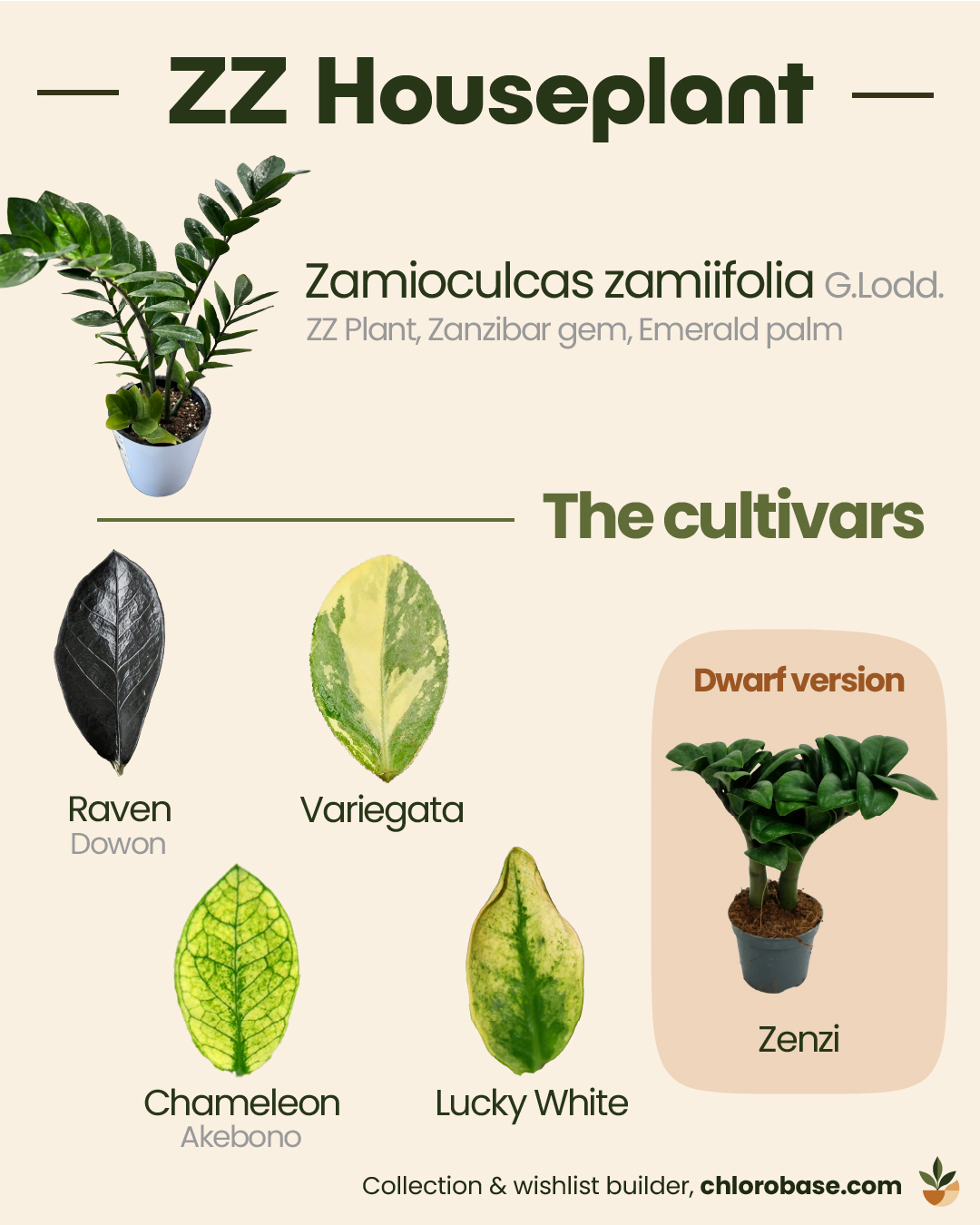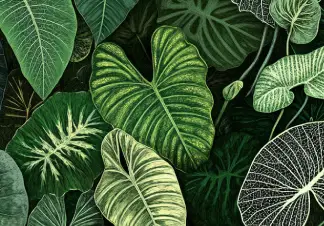Beyond the classic green: exploring the diverse varieties of Zamioculcas zamiifolia (ZZ plant)
Hey plant friends, Anthony here from Chlorobase! Isn't it a fantastic feeling when you discover there's more to a beloved plant than you initially thought? You know, that moment when a familiar favorite reveals a whole family of unique siblings? That's exactly how I feel about Zamioculcas zamiifolia, often known affectionately as the ZZ plant.
This stalwart of the houseplant world is celebrated for its easy-going nature and architectural beauty. But beyond the classic deep green, there's a fascinating array of cultivars, each with its own distinct charm. Today, I want to take you on a journey to explore these incredible variations. We're going to discover the diverse world of Zamioculcas zamiifolia varieties, and I bet you'll find a few new ones to admire (and maybe even add to your Chlorobase Wishlist, like I do!).
The original icon: Zamioculcas zamiifolia
Before we dive into its exciting offspring, let's appreciate the parent plant itself: the standard Zamioculcas zamiifolia.

zamioculcas zamiifolia
This plant is a true champion of resilience. Hailing from Eastern Africa, it's adapted to thrive in arid conditions, storing water in its thick, fleshy rhizomes and glossy leaves. This toughness translates wonderfully to our homes, making it famously low-maintenance. Its iconic look features upright stems adorned with symmetrically arranged, deep green, shiny leaflets, giving it a naturally sculptural and modern appeal. It's no wonder the ZZ plant has become a staple in households and a favorite for both beginner plant parents and seasoned collectors. It truly sets a high bar!
A quick visual guide to ZZ varieties
To help us appreciate the differences at a glance, we've put together a visual chart. It's a great way to quickly compare leaf shapes, colors, and growth patterns across the different cultivars we'll be discussing. We only covered easily differentiated cultivars because some of them are really visually similar. If you want more details on the others, look below in this guide!

We encourage you to share this chart! If you do, please remember to attribute it to Chlorobase.
Meet the Zamioculcas zamiifolia family
Alright, let's get to the main event! Here are some of the captivating varieties that showcase the versatility of the ZZ plant. I've tried to highlight what makes each one special.
Zamioculcas zamiifolia 'Raven' – Dramatic Black Foliage

zamioculcas zamiifolia 'raven'
The 'Raven' is a showstopper, no doubt about it. Its new growth emerges a bright, vibrant green, but as the leaves mature, they transform into a stunning, near-black, glossy hue. This dramatic foliage creates a striking contrast and adds a touch of sophisticated drama to any plant collection. It originated in South Korea in 2006 from a natural mutation and is also known by its cultivar name 'Dowon'. It's patented under USPP30035.
Zamioculcas zamiifolia 'Supernova' – Deep Dark Form

zamioculcas zamiifolia 'supernova'
Similar to 'Raven' in its dark allure, 'Supernova' (also known by cultivar names 'Heemsprix' or 'Heemzamio') presents dark green, almost black leaves and stems. It tends to grow in a more compact, upright clump with leaves that have distinctly pointed tips. Sources suggest it typically remains a bit smaller than 'Raven' and its stems are often thinner and more consistently dark. This variety was discovered in the Netherlands in 2012 and is patented (USPP26262).
Zamioculcas zamiifolia 'Dark Zamicro' – Compact Dark Dwarf

zamioculcas zamiifolia 'dark zamicro'
Taking the dark foliage trend to a smaller scale, 'Dark Zamicro' offers those near-black leaves on a more compact plant. It's essentially a darker version of the 'Zamicro' (which we'll meet next), featuring smaller leaflets and an upright, more diminutive stature compared to 'Raven' or 'Supernova'. It was discovered in The Netherlands in 2013 as a mutation of 'Zamicro' and is protected under US20170311530.
Zamioculcas zamiifolia 'Zamicro' – Miniature Stature

zamioculcas zamiifolia 'zamicro'
For those who love the classic ZZ look but are short on space, 'Zamicro' is a perfect fit. This cultivar is notably more compact and shorter than the standard species, with relatively small, shiny, dark green leaves. It maintains the classic ZZ appeal in a downsized package. It was discovered in The Netherlands in 2002 and is patented (USPP19314).
Zamioculcas zamiifolia 'Zenzi' – Curly Compact Form

zamioculcas zamiifolia 'zenzi'
'Zenzi', also known by its cultivar name 'HANSOTI13', is quite distinctive with its compact growth and somewhat curly, dense foliage. The leaflets are closely spaced along thick, sturdy stems, and the leaves themselves are stiff, upright, and have a noticeable curve, giving the plant an overall urn-like or bonsai-esque appearance. This unique form was discovered in India in 2009 and is patented (US20150163985).
Zamioculcas zamiifolia 'Lucky' – Rounded Leaf Charm

zamioculcas zamiifolia 'lucky'
The 'Lucky' cultivar offers a subtle but charming twist on the classic ZZ. It's characterized by its uniquely rounded leaf tips, which soften its overall look. It also tends to maintain a more compact growth habit than the standard species. Discovered in The Netherlands in 2003, this one is patented under USPP23594.
Zamioculcas zamiifolia 'Midori' – Upright Oval Leaves

zamioculcas zamiifolia 'midori'
'Midori', also known by its cultivar name 'ZAM202201', forms compact, upright clumps. Its dark green, glossy leaves are broadly oval and point upwards. It's described as staying smaller and clumping more freely than some other types, with its individual leaflets being more rounded and closer together. This cultivar was discovered in The Netherlands in 2020 and is patented (USPP35642).
Zamioculcas zamiifolia 'Variegata' – Classic Streaked Variegation

zamioculcas zamiifolia 'variegata'
The 'Variegata' is what many collectors think of when they hear "variegated ZZ." It's recognized by its irregular patches and streaks of lighter colors – creamy white, pale yellow, or light green – splashed across the deep green leaflets. These beautiful patterns can vary significantly from leaf to leaf, and sometimes even appear on the stems. It's thought to be one of the earliest variegated forms, likely arising from a natural mutation.
Zamioculcas zamiifolia 'Lucky White' – Cream-Kissed & Wavy

zamioculcas zamiifolia 'lucky white'
'Lucky White' brings a distinct variegation pattern, with striking splashes and blocks of light cream color mixed in with the green. A particularly interesting feature is that the edges of its leaflets are often noticeably wavy or curled, adding another layer of texture. Discovered in The Netherlands in 2007, this variety is patented (USPP23614). Some sources mention it can be a bit unstable, which is something to keep in mind with highly variegated plants.
Zamioculcas zamiifolia 'Chameleon' – Color-Changing Foliage

zamioculcas zamiifolia 'chameleon'
True to its name, 'Chameleon' (sometimes associated with 'Akebono' style variegation) is fascinating because its leaves change color over time. New growth can emerge in shades of yellow or light green, gradually maturing to a darker green. This means a single plant can display a beautiful mosaic of pure yellow, pure green, and mixed-color leaves all at once! It was discovered in Thailand in 2017 and is patented (USPP32253).
A general word on caring for your ZZs
One of the best things about Zamioculcas zamiifolia and its cultivars is their general hardiness. For the most part, their care is quite consistent:
-
Light:
They are famously tolerant of low light conditions, but they'll thrive and grow more robustly in medium to bright indirect light. Avoid harsh, direct sun, which can scorch their leaves.
-
Watering:
Less is definitely more. Allow the soil to dry out completely between waterings. Their rhizomes store water, making them very drought-tolerant. Overwatering is the most common issue.
-
Soil:
A well-draining potting mix is crucial. A cactus or succulent mix, or a general houseplant mix amended with perlite or sand, works well.
-
Humidity:
Average household humidity is usually fine. They aren't particularly fussy.
A note on variations: While care is generally similar, you might find that some of the highly variegated types (like 'Variegata' or 'Lucky White') appreciate slightly brighter indirect light to maintain their vibrant colors. As always, observing your specific plant and its environment is key. That's why our individual plant pages here on Chlorobase are so handy for diving into specifics!
So many ZZs, so much to appreciate!
It's truly wonderful to see how much diversity can come from one already fantastic plant species. From the deepest blacks of 'Raven' and 'Supernova' to the compact charm of 'Zamicro' and 'Zenzi', and the painterly variegation of 'Variegata' and 'Chameleon', there's a Zamioculcas zamiifolia cultivar out there to capture every plant lover's heart.
I hope this exploration has given you a new appreciation for the ZZ plant family. I always find it helpful to keep track of the plants I own or the ones I'm dreaming about. Using tools like our Collection and Wishlist features on Chlorobase can make organizing your plant journey much easier – I know I use them all the time to keep my own green ambitions in check!
Feel free to click into any of the plant images or links above to explore their individual pages for more detailed information.
Until next time, plant friends, happy growing!
Anthony
